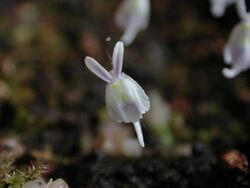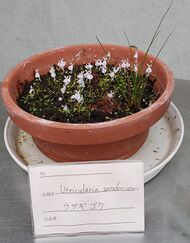Biology:Utricularia sandersonii
| Utricularia sandersonii | |
|---|---|

| |
| Scientific classification | |
| Kingdom: | Plantae |
| Clade: | Tracheophytes |
| Clade: | Angiosperms |
| Clade: | Eudicots |
| Clade: | Asterids |
| Order: | Lamiales |
| Family: | Lentibulariaceae |
| Genus: | Utricularia |
| Subgenus: | Utricularia subg. Bivalvaria |
| Section: | Utricularia sect. Calpidisca |
| Species: | U. sandersonii
|
| Binomial name | |
| Utricularia sandersonii Oliv.
| |
| Synonyms | |
| |
Utricularia sandersonii, Sanderson's bladderwort, is a species of flowering plant in the bladderwort family. Originally described and published by the British botanist Daniel Oliver in 1865, it is a carnivorous evergreen perennial, endemic to northern KwaZulu-Natal and Transkei in South Africa.
Description
Up to 50 cm (20 in) tall and broad, it grows as a lithophyte on wet, often vertical rocky surfaces at altitudes from 210 m (689 ft) to 1,200 m (3,937 ft).[1] Carnivory occurs beneath the surface, whereby tiny bladders on underground stems capture the micro-organisms which inhabit saturated soil. The visible parts of the plant are not carnivorous. Above ground it bears quantities of white flowers with pale blue markings, long forward-curved spurs and double lobes which resemble rabbits' ears.[2]
Cultivation
Utricularia sandersonii thrives in conditions that are relatively easy to replicate at home, and so has become a popular houseplant which can tolerate temperatures down to 1 °C (34 °F), but not freezing. It must be kept moist at all times and requires moderate lighting for continuous flowering. It is not able to perform self-pollination, so a male and a female specimen is needed for sexual reproduction, but asexual reproduction by fragmentation is much faster and easier. It has gained the Royal Horticultural Society's Award of Garden Merit.[2][3]
Invasive plant
U. sandersonii is listed on the New Zealand National Pest Plant Accord since it is an invasive species.[4]
See also
References
| Wikimedia Commons has media related to Utricularia sandersonii. |
- ↑ Taylor, Peter. (1989). The genus Utricularia – a taxonomic monograph. Kew Bulletin Additional Series XIV: London.
- ↑ 2.0 2.1 "RHS Plantfinder - Utricularia sandersonii". https://www.rhs.org.uk/Plants/18633/i-Utricularia-sandersonii-i/Details.
- ↑ "AGM Plants - Ornamental". Royal Horticultural Society. July 2017. p. 103. https://www.rhs.org.uk/plants/pdfs/agm-lists/agm-ornamentals.pdf.
- ↑ "Carnivorous weeds in Auckland" (in en-nz). https://www.doc.govt.nz/nature/pests-and-threats/weeds/common-weeds/carnivorous-weeds-in-auckland/.
Wikidata ☰ Q140405 entry
 |


